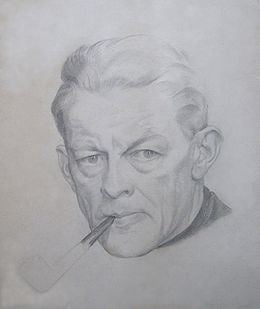Nationality American Period Art Deco | Movement Art deco | |
 | ||
Awards Widener Gold MedalHerbert Adams Memorial MedalNational Academy of Design: E. N. Watrous Gold Medal Died 5 September 1956, New York City, New York, United States | ||
Cecil de Blaquiere Howard, sometimes Cecil Howard, (April 2, 1888 - September 5, 1956), born in Clifton, Welland County, Ontario, Canada, today Niagara Falls was a Canadian-American painter and sculptor.
Contents
Biography
Howard was the fourth child of British businessman George Henry Howard (1840-1896) and his wife Alice Augusta (née Framer, 1850-1932). Cecil as the youngest son was given his maternal grandmother name "de Blaquiere" as a middle name. With the move to Buffalo (New York) in 1890, the family took American citizenship.
Howard left school early to study art at the Albright–Knox Art Gallery and with James Earle Fraser (sculptor) at the Art Students' League in Buffalo.
At the early age of sixteen he traveled to Paris to study at the Académie Julian with Raoul Verlet. In Paris he met Aristide Maillol who influenced his early pieces presented at the Salon d'Automne. Some pieces were acquired by Gertrude Vanderbilt Whitney. He supported himself with fashion drawings and by teaching the Argentine tango. He befriended Rembrandt Bugatti, whom he accompanied in 1909 on a journey to Antwerp, where together they made drawings and sculptures of animals in the Zoological Garden. Howard later destroyed many of these sculptures, as he regarded them inferior in comparison to Bugatti's works.
In 1910 he moved to a studio on the Avenue du Maine and devoted his work to the presentation of the human body in various circumstances and styles, in sports or at rest, experimenting with figurative, polychrome sculptures, cubism, traditional African art, art deco, classicism or neoclassicism. Using different techniques and mediums like clay modeling or direct carving, of stone, marble, wood, working in plasticine, terracotta, plaster, wax, bronze or silver. After World War I , he received commission to create two memorial monuments in Normandy.
Howard spent his life between France, England and the United States, where he also regularly exhibited. Among others, his sculptures Woman and The artist were presented in New York at the Armory Show in 1913. He also participated in the Century of Progress fair in Chicago in 1933 and in 1937, in the Exposition Internationale des Arts et Techniques dans la Vie Moderne.
Until 1939, while residing in France, Howard shared his time between Paris and Brittany where he met Henry Luce who commissioned some of his work. During World War II, Howard drove a Red Cross truck carrying food and medicine to prison camps. In late 1943, Cecil Howard exhibited at the Pennsylvania Academy of Fine Arts, a male nude sized, entitled American Youth or The Sacrifice, rewarded in 1944 by the George D. Widemer Memorial Gold Medal from the Academy. The same year, he was recruited by the Office of Strategic Services . From 1945 onward he worked for the United States Office of War Information. In January 1944 he became the sixteenth president of the National Sculpture Society.
Howard died in New York in 1956 and was posthumously awarded the E. N. Watrous Gold Medal from the National Academy Museum and School in 1957.
